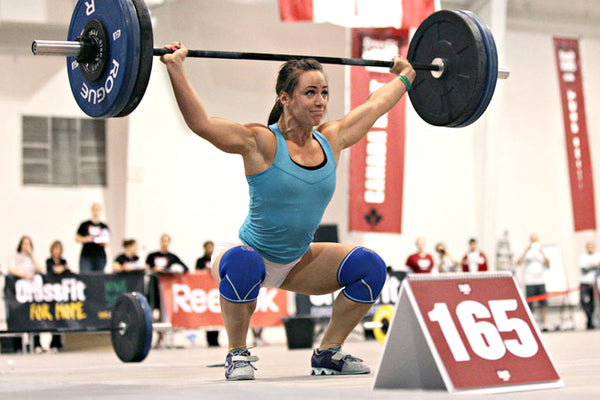Walk into any gym (be it powerlifting, CrossFit, or big box commercial gym), and you’re bound to see people wearing all sorts of wraps, sleeves, and weightlifting belts.
You may have even wondered if you should be wearing some of these various pieces of lifting equipment.
But, are they actually required to lift?
Do they serve any purpose?
Or, are they just another in a long line of fitness fads that need to die?
In this article, we’ll answer those questions and more as we discuss the benefits of using wraps and/or sleeves when lifting heavy.
First, let’s discuss the differences between wraps and sleeves.
Lifting Sleeves vs Wraps
Sleeves
As the name implies, sleeves are compression garments that surround a joint (typically the knee or elbow). It is made from neoprene and comes in a variety of sizes and thicknesses. The tight fit of the sleeves on your joints keeps them warm by increasing blood flow to the area during your workout.
It’s also believed that wearing sleeves helps lifters (particularly when squatting). Sleeves can offer better feedback as to the placement and tracking of the joint during a lift. As a result of this kinesthetic awareness, lifters have greater potential for better technique during lifting.
Sleeves are commonly worn to reduce the risk of damage and protect the knee from injury when lifting heavy (>80% 1-RM).
One final benefit from the compressive forces placed on the joint from sleeves is that the enhanced blood flow may also decrease pain and swelling during and after a high-intensity training session..
Wraps
Now, wraps, on the other hand, are made of thick polyester that is interwoven with rubber filaments. They are wrapped around the knees or wrists in a spiral or figure 8 pattern.
The biggest difference between sleeves and wraps is that wraps offer a mechanical advantage to lifters due to the rubber filament interwoven into the wraps, which help the lifter out of the bottom position and lift the weight.
Interestingly, some studies note that wearing wraps may help athletes lift the weight up to 20% faster out of the hole.[1,2]
Knee wraps are also believed to help reduce stress and pulling forces on the quadriceps tendon, which attaches the quads to the kneecap (patella).
Benefits of Weightlifting Wraps & Sleeves
Stability & Support
Joints are complex entities as they serve as the junction between muscles, bones, tendons, and ligaments. They allow us to move freely and without pain. However, approaching a max effort lift can place considerable strain on the joints.
Sleeves and wraps help create added stability and support at these vital junctures, allowing us to safely attempt higher intensity work in our training sessions.
Push Harder
If a joint feels a bit “off” or not-stable, you may not be able to push as hard as you would like for fear that you may injure yourself. Since sleeves and wraps help reduce pain and improve stability, they may give you the confidence to push past your present limits and attain new feats of strength, power, and performance in your workouts.
Decreases Risk of Pain and Injury
Sleeves and wraps increase blood flow to the joint area, keeping them warm and lubricated. When your joints are in this state, they are better able to stretch and perform at an optimal level, thereby lessening the risk of injury or pain when training.
Furthermore, since wraps and sleeves also help provide support and stability, they help keep the joints safe as you fatigue during your workout.
Recovery
As we mentioned before, sleeves and wraps increase blood flow to the area around your joints and help reduce inflammation that occurs during and after intense workouts. Greater blood flow combined with less inflammation promotes faster recovery, which allows you to get back in the gym more frequently and keep making progress!
When Should I Use Weightlifting Sleeves and/or Wraps?
Let’s make one thing clear -- sleeves and/or wraps do not need to be worn for every set of every exercise in your workout.
Also, if you’re fairly new to lifting weights, you don’t need to worry about sleeves or wraps as you likely aren’t dealing with loads heavy enough to place considerable pressure or stress on your joints.
Furthermore, do not use wraps and/or sleeves as a band-aid (“cover-up”) for existing joint pain and/or injury. If you are presently dealing with joint pain during a given exercise, investigate why you are having joint pain in the first place and work to address the underlying issues. Wraps and sleeves should not be used to cover up pain or dysfunction.
All that being said, sleeves and wraps are best incorporated for your heaviest training sessions or powerlifting meets.
Takeaway
The decision to use weightlifting wraps or sleeves is based on training experience, goals, injury history, and much more. Plenty of exceptional athletes perform well without them, and there are a great many who find them beneficial when training with max loads.
Wraps and sleeves help provide support and stability while limiting stress on the joint, making them a great option for those who like to train heavy. But, remember to use them sparingly. They aren’t meant to be used for every rep of every set of every training session.
References
- Harman E & Frykman P. The effects of knee wraps on weightlifting performance and injury. J Strength Cond Res. 1990; 12:30-35
- Lake JP, Carden PJC, Shorter KA. Wearing knee wraps affects mechanical output and performance characteristics of back squat exercise. J Strength Cond Res. 2012; 26(10):2844-2849






